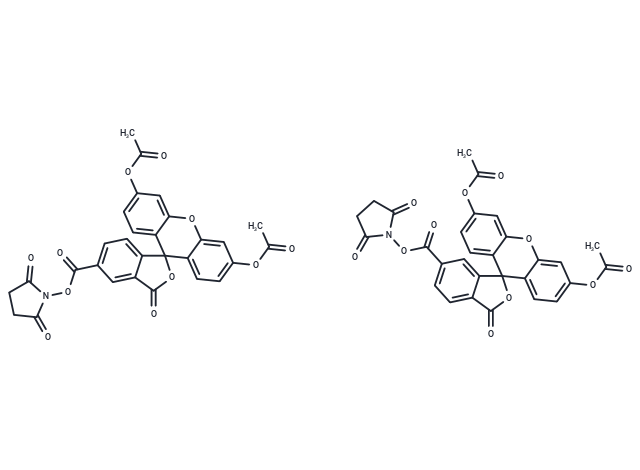Shopping Cart
- Remove All
 Your shopping cart is currently empty
Your shopping cart is currently empty

CFSE (CFDA-SE) is a fluorescent dye with cell membrane permeability. CFSE irreversibly binds to intracellular proteins in living cells and is used for the detection of cell proliferation. The labeled cells fluoresce in green color with excitation wavelength of 488 nm and emission wavelength of 518 nm.

| Pack Size | Price | Availability | Quantity |
|---|---|---|---|
| 5 mg | $52 | In Stock | |
| 10 mg | $80 | In Stock | |
| 25 mg | $133 | In Stock | |
| 50 mg | $198 | In Stock | |
| 100 mg | $293 | In Stock | |
| 200 mg | $438 | In Stock | |
| 1 mL x 10 mM (in DMSO) | $74 | In Stock |
| Description | CFSE (CFDA-SE) is a fluorescent dye with cell membrane permeability. CFSE irreversibly binds to intracellular proteins in living cells and is used for the detection of cell proliferation. The labeled cells fluoresce in green color with excitation wavelength of 488 nm and emission wavelength of 518 nm. |
| In vitro | METHODS: 1 mL of cells and CFSE (5 μM in 110 μL PBS) were flipped and mixed to label the cells. CFSE-labeled CD8+OT-I T cells were cultured with dendritic cells pulsed with varying amounts of OVA for 3 days, and CFSE profiles were examined using Flow Cytometry.
RESULTS: CD8+ T cells divided 1-3 times according to the CFSE dilution peak, and more T cells divided at higher antigen concentrations. [1] METHODS: Human erythroleukemia cell line K562, mouse lymphoma cell line YAC-1, human breast cancer cell line MCF-7, and human melanoma cell line A375 were treated with CFSE (1-10 μM) for 1-6 h. Cell death was detected by Flow Cytometry. RESULTS: CFSE was non-toxic to the cells, as the cell death rate due to CFSE labeling was less than 5%. [2] |
| In vivo | METHODS: CFSE-labeled CD8+OT-I T cells were injected intravenously into the tail of C56BL/6J mice, followed by intravenous injection of OVA (20 μg), and CFSE profiles were measured three days later.
RESULTS: Most of the cells fell within 7 CFSE peaks, indicating that the cells had undergone up to 6 divisions. [1] METHODS: To label thymocytes in vivo, CFSE (10 μM) was injected into the thymic lobes of anesthetized C56BL/6 mice. RESULTS: CFSE labeled a representative sample of all thymocyte subpopulations and these cells migrated to peripheral lymphoid organs at a rate of approximately 2-3 x 10^6 cells/day. They enter the lymph nodes on day 1 post-injection and remain there for at least 21 days, while turnover is faster in the spleen. [3] |
| Cell Research | The 5 mM CFDA-SE stock in DMSO is diluted to different concentrations(2 μM, 3 μM, 4 μM, 5 μM, 10 μM and 20 μM) in PBS with a total volume of 1 ml. After each cell line is harvested and washed three times with PBS, 1×109 cells are added to equal volume of CFDA-SE with different concentrations and incubated at 37°C for 5, 6, 7, 8, 10 and 15 min with agitation. The labeling reaction is stopped for 1 min by adding an equal volume of heat inactivated fetal bovine serum. The CFDA-SE labeled cells are washed twice with PBS and recounted, and the cell concentration is adjusted to 6×104cells/ml in IMDM containing 10% FCS.(Only for Reference) |
| Alias | CFDA-SE, Carboxyfluorescein succinimidyl ester, 5(6)-CFDA N-succinmidyl ester, 5(6)-Carboxyfluorescein diacetate succinimidyl ester |
| Molecular Weight | 557.46 |
| Formula | C29H19NO11 |
| Cas No. | 150347-59-4 |
| Smiles | CC(=O)Oc1ccc2c(Oc3cc(OC(C)=O)ccc3C22OC(=O)c3cc(ccc23)C(=O)ON2C(=O)CCC2=O)c1.CC(=O)Oc1ccc2c(Oc3cc(OC(C)=O)ccc3C22OC(=O)c3ccc(cc23)C(=O)ON2C(=O)CCC2=O)c1 |
| Relative Density. | 1.6 g/cm3 |
| Storage | keep away from direct sunlight | Powder: -20°C for 3 years | In solvent: -80°C for 1 year | Shipping with blue ice. | |||||||||||||||||||||||||||||||||||
| Solubility Information | Ethanol: < 1 mg/mL (insoluble or slightly soluble) DMSO: 93 mg/mL (166.83 mM), Sonication is recommended. H2O: < 1 mg/mL (insoluble or slightly soluble) | |||||||||||||||||||||||||||||||||||
Solution Preparation Table | ||||||||||||||||||||||||||||||||||||
DMSO
| ||||||||||||||||||||||||||||||||||||

Copyright © 2015-2025 TargetMol Chemicals Inc. All Rights Reserved.